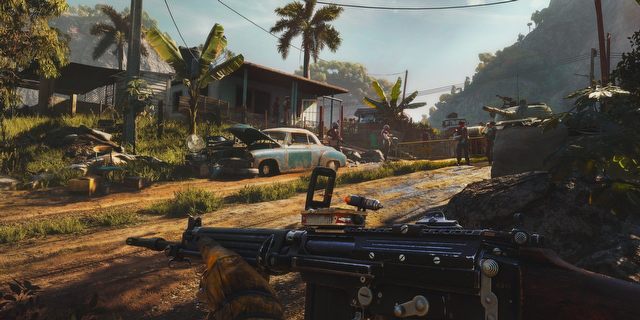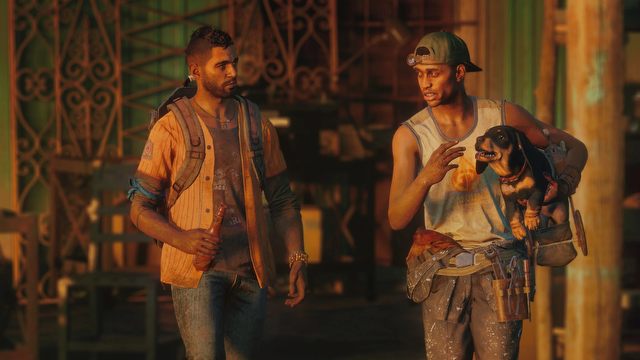Far Cry 6 Preview - War Drama vs. Teen Comedy
The latest Far Cry features a huge open world, a vicious civil war on a tropical paradise island, and a psychologically complex enemy to contend with. With yet another installment, the series strives to mix its pedigree with fresh ideas.
We've seen Far Cry 6, and for the second time. What's hardly surprising is that this time, we've seen a little more of the game. After the American wasteland overrun by a sect, we move to a fictional island in a fictional country again. This time around, we're headed to a fictionalized version of Cuba. It's a republic separated from the world, somewhere in the Caribbean, ruled by a dangerous, waning dictator who's preparing a succession. Sounds like quite a few places in the world right now.
From interviewing former guerillas and researching, I think the worst thing is not knowing what’s going to happen next. You’re not able to predict which whay the conflict will go. On top of that, there’s the risk of losing your loved ones.
Navid Khavari, narrative director
This is already the late stage of the regime, with parts of the population hiding and fighting an all-out guerrilla war to the death. The trailer also mentioned labor camps, and we saw a propaganda TV interview with Anton Castillo, the dictator of Yara Island.
The player can decide whether to play as female or male protagonist but it's mostly a cosmetic choice. In both cases, we come from good families, but decide to stand up to the oppressive junta and join the rebellion.
One of the things we really explored in Far Cry 6 was that everyone involved in the fight, every guerilla, every civilian has their own reasons, and opinions about the conflict. Some have lost loved ones, others may have deflected from the military, others might fight just for the thought of it, as that absolutely happens. For us, it was really about trying to capture the complexity of that narrative. There’s so many stories to a revolution, and we wanted to honor that.
Navid Khavari, narrative director
The story is looking really good. In the game, we'll be able to holster our weapons and blend in with the crowd. Civilians and urbanized areas will also be part of the landscape. This is a very pleasing new direction for the series, and since sabotage actions are on the agenda, we're expecting stealth to be more complex and interesting.
Yara is an open-air museum, almost completely remote. We've got decades-old cars, Soviet-era tanks, and I definitely spotted the iconic, Russian PPS, and, if I'm correct, an MP-18 SMG. The rebels also use Molotov cocktails, go boating, ride horses, and hide in underground bunkers. It's still Far Cry, so explosions and roaring machine gun fire will fill most of our play time.
Aiming for credibility...
The Far Cry series suffered to some extent because the technical capabilities of the hardware couldn't handle the scope these games needed. The tropical island that contained a few dozen wooden huts was inhabited by at least a few hundred bandits armed to the teeth, and then even some locals.
In the Himalayas, we defeated a dictator of a state that consisted entirely of forests, small outposts, and a few friendly settlements; then, in Montana, mostly a middle of nowhere, we were attacked by helicopters of religious zealots, whom we killed in veritable thousands. After all, they were showing up all over the place, and it was only a matter of perseverance to achieve such a score.
This dissonance between the setting and action was never something that ultimately spoiled the gameplay. Looking at the towns on Yara Island, however, I feel that we finally get a an environment that can match the projected scale of the conflict.
Also, the overall vibe seems quite serious. Anton Castillo makes a much better impression than Joseph Seed, not to mention Mickey and Lou. It's closer to Pagan Min, my favorite villain of the series. The dictator of Kyrat was ostentatious, stylish, had temper tantrums, and could be very violent, but also had interesting background. So far, Anton just seems like he might resemble him, but what I liked the most here is the fact that he doesn't seem a ridiculous caricature, isn't reduced to a tokenized antagonist. You can see that the writers have taken the time to really figure out what they want to tell us, and that it won't necessarily be an easy story.
One of the questions we wanted to ask ourselves was: "When does the revolution begin?" “What is it that makes an ordinary citizen grab a rifle and dive into battle?” Then you go deeper than that: “When does your revolution end?”. “Are you fighting for your people, or just the adrenaline?”. Those are all themes we wanted to tackle.
Navid Khavari, narrative director
I was quite happy about it, and as I was becoming hyped...
...But why is the crocodile wearing a tracksuit?
The beautiful and serious game about freedom-fighting guerrillas was mixed at some point with a completely different Far Cry, one more in the spirit of Watch Dogs 2. As a fighter, we will team up with a more experienced guerilla, who provides access to equipment. As it turns out, this man's personal bouncer is a crocodile in a tracksuit. During a cutscene, the man made a careless gesture and his pet charged at an assassin like a faithful dog. We also have a sausage dog in a canine wheelchair. It's kinda sweet, but somehow dissonant with the subject matter.
I didn't pass the opportunity to ask directly why the game featured a large predatory reptile in athletic attire.
That’s a thing with this fantasy, and it really comes from talking to actual guerillas. We went down to Cuba and when we were talking to some of them, they made very clear, and even pushed back against the narrative, because “it was serious all the time.” They would be playing music late into the night, being surrounded, with military planes dropping bombs around. That juxtaposition was fascinating to explore, and we wanted to honor that sense of fun.
Navid Khavari, narrative director
Of course, the madness doesn't end here. The game also features weapons created from trash and scrap. For example, an M134-Minigun-style rifle, made fully from recycled materials. I also saw something that looked very much like a combat CD launcher. This, of course, is not everything. We also have special backpacks, providing some unique capabilities.
I noticed two of them during the show. One was a kind of rocket artillery system or, simply put, a portable Katyusha. Our character leans over, deploys, and launches a salvo of rockets from his backpack that destroy, for example, a tank. The other model allowed you to fly. Rather not very high, but yes – it was a functional jetpack.
A cavalry charge on the enemy, with Molotov cocktails in hand, is not even worth mentioning at this point. .
It’s part of the brand, as well. You have to find the balance of it, but I think we struck a good one, and it feeds into the fantasy of the guerillas.
Navid Khavari, narrative director
I myself would say that these elements are not so much part of Far Cry heritage, as they are just becoming one. We've already had a dose of crazy and bizarre in the series. At some point, probably most notably in part five, the intensity peaked, and quite noticeably. What I saw leads me to believe that Ubisoft is mostly sticking to their guns, following closely the latest installment, and it's subsequent expansion, the New Dawn. Let me be clear – I'm not a huge fan of this direction, but that doesn't mean it's bad in and of itself.
Remember that a key ingredient of the Far Cry series, at least since its second installment, has always been freedom. It may just turn out that after swallowing the jetpack and the crocodile, we may be able to focus on the more serious stuff.
After what I've seen, I'm both apprehensive, as I would have preferred an overall more serious approach to the game, but at the same time, the first next-gen Far Cry seems very sexy to me with its vastness of land and opportunities. Cities, tanks, and old cars – I will definitely give this game a chance.



